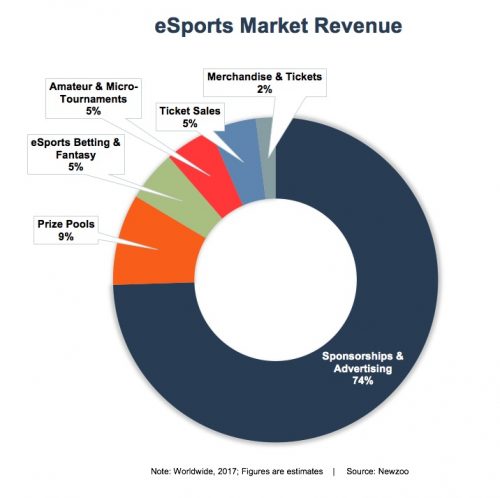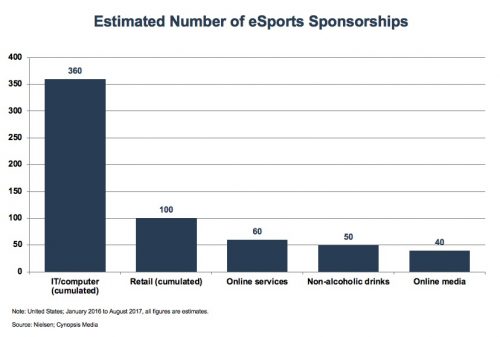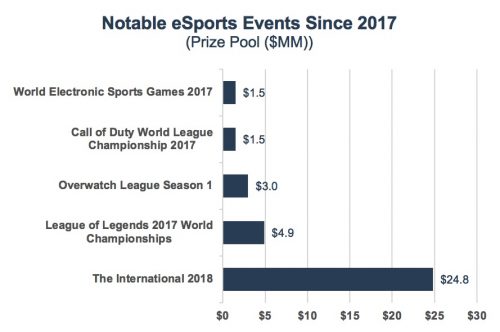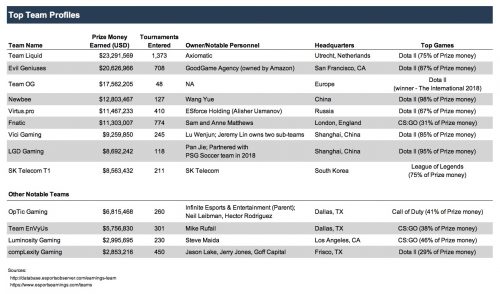eSports: Business Models
How an eSports Team Makes Money
An eSports team can make money in a variety of ways, including broadcast revenue, sponsorships, merchandise sales, and subscriptions. The sources of revenue are detailed below.
Sponsorships
As shown in the chart above, sponsorships and advertising account for the bulk of revenue for eSports. According to Patrik Sättermon (Fnatic’s Chief Gaming Officer), “[I]t is estimated that around 95% of the money generated by our eSports teams comes directly from sponsorship deals.” The novelty of eSports has attracted many well-known sponsors; however, teams have struggled to make sponsorships a sustainable source of revenue. The relatively short life of popular games proves to be an impediment to sustained sponsorship. A game might be highly popular currently but within a year fade from public interest.
IT/Computer related sponsorships are the most common in the eSports industry as gaming equipment and accessories are prominently displayed during events. For example, HP and Intel agreed to sponsor Activision Blizzard’s Overwatch League. As part of the agreement, competitors will exclusively use HP’s OMEN gaming PCs and displays.
From a valuation perspective, consistent recurring revenue is a benefit to the value of a company. Sponsorships can provide long-term recurring revenue to an eSports teams.
Broadcast Revenue
eSports broadcasting on TV is still in its infancy as broadcasters look for eSports content that will appeal to their target demographics. ELEAGUE, an eSports content and live tournament brand, has a broadcasting deal with TBS that shows Street Fighter V and Counter Strike: Global Offensive (“CS:GO”) on TV. The recently formed Overwatch League (“OWL”), will be broadcast on the ESPN, Disney, and ABC family of networks. Perhaps most importantly, a broadcast TV deal does not cancel existing distribution agreements such as broadcasts on Twitch that were already in place.
While game developers and league creators are able to come to broadcast agreements, it is more difficult for eSports teams. eSports teams generally do not share in broadcast revenues as those agreements are negotiated between game developers/league creators and the broadcasting entities.
Merchandise Sales
As mentioned in our eSports industry overview, consumer spending on eSports merchandise remains relatively low. eSports teams offer apparel, accessories, and gaming equipment through their team websites. From a valuation perspective, merchandise sales can be a source of supplemental income. However, merchandise sales would not have a significant impact on the valuation of an eSports team because the revenue tends to be small and non-recurring.
Prize Money
Prize money typically does not go to eSports teams, but rather, to individual team members who are competing. While the team does not receive the money, being successful in tournaments is a good way to generate brand awareness.
As the eSports industry expands, so have prize pools for tournaments. In August 2018 Vancouver hosted The International 8 – the eighth annual Dota 2 championship tournament. The total prize pool of $24.8 million sets the record for largest single tournament prize pool in eSports history. The International prize pool compared to other notable sports events from 2018 is presented below.
Perhaps the most interesting note from the $24.8 million prize pool for The International is that approximately 94% was crowdfunded. Every-day Dota 2 players purchased Battle Passes that offer event-exclusive features and rewards. One-fourth of each Battle Pass was added to the prize pool.
Naming Rights
Team Liquid officially opened a new training facility March 7, 2018, in Santa Monica, California. The facility not only provides a dedicated practice area for Team Liquid members but also houses the company’s content production team, 1UP Studios. “Teams in the [U.S.] have traditionally operated out of ‘gaming houses’ where players and coaching staff for a team live and practice in a single residential home.”
The development of a dedicated training facility represents a shift away from the current model. The training facility has provided another stream of revenue for Team Liquid as they were able to sell naming rights to the facility to gaming PC brand Alienware for $4.5 million. Team Liquid’s CEO Steve Arhancet indicated the team spent over $1.5 million in building the training facility.
Generally speaking, eSports teams owning their training facilities is a recent trend. As eSports continue to grow, it is likely we will see more sales of naming rights for facilities.
Successful Teams
The table below shows the top teams based on prize money earned as well as four other notable teams.
Subscriptions
Luminosity Gaming ranked number 29 in terms of prize money earned among eSports teams. However, Luminosity also boasts arguably the most well-known eSports player in the world, Tyler Blevins (aka Ninja). Ninja recently revealed that he makes $500,000 per month from his more than 160,000 paid Twitch subscribers. On Twitch, streamers net $3.50 per subscription, which costs subscribers $5.00 per month. Twitch subscribers receive access to exclusive badges and ad-free streams.
Having high-profile players on the roster can increase the visibility of an eSports team and therefore lead to more followers and eventually subscribers. Subscriptions are another source of recurring revenue for a team.
Costs of Revenue
As with any business, there is a cost to generating revenue. eSports teams get most of their revenue from sponsorships. In order to attract sponsors, teams must perform well at tournaments and events as well as be highly visible to consumers. Typical expenses for an eSports team include player salaries, administrative personnel salaries, player housing expenses, training facility rent or operating expense, and equipment/accessory expense.
In 2017, Jerry Jones acquired an ownership interest in Complexity Gaming. Shortly thereafter, the team was moved to The Star in Frisco. The Star happens to be the Dallas Cowboys World Headquarters. The plan is for Complexity to build a “state-of-the art operations center and global headquarters including offices, production studios, and industry leading training facilities.”
Complexity are not the only team to take advantage of common ownership with another pro sports team. In April, Team Dignitas spent time with Philadelphia 76er trainers and nutritionists in order to prepare for the Intel Extreme Masters in Poland.
The Takeaway
There are numerous ways for an eSports team to make money. In general, the most common source of revenue is sponsorships. In order to increase sponsorships eSports teams need to perform well in the tournaments they enter. Merchandise sales, prize money, and broadcast revenue are other ways eSports teams can make money. Most eSports teams have similar expenses so profitability of a specific team usually depends on performance at the top line.
Chris Mercer, founder of Mercer Capital, states the two primary factors in the value of a business are risk and growth. eSports teams with a significant amount of recurring revenue (through sponsorships, subscriptions, etc.) are less risky than teams that have less consistent revenue sources (prize money, merchandise sales). The less risky an entity, the greater the value of that entity.
Originally published in Mercer Capital’s eSports: Business Models whitepaper.






